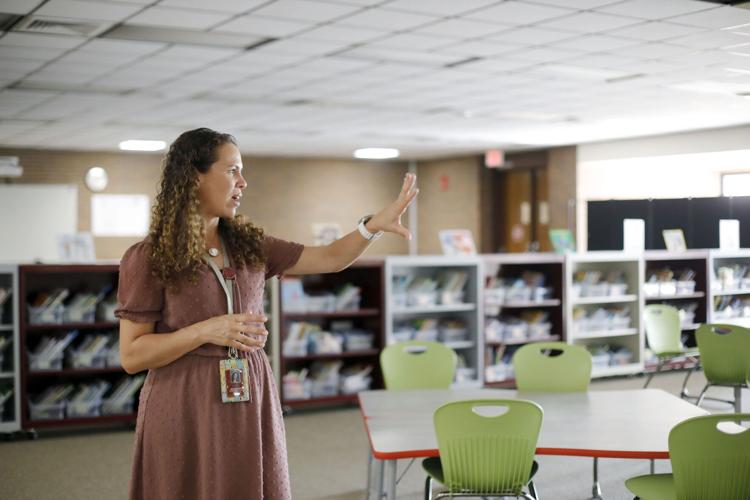PITTSFIELD — Like all Pittsfield Public Schools principals, Candy Allessio of Crosby Elementary School was asked to reduce her share of the fiscal year 2026 budget by 2.15 percent — $91,369, to be precise.
Allessio addressed that task with a goal: saving an attendance coordinator whose efforts have reduced chronic absenteeism at Crosby. In the process, she managed to help another inner-city elementary school avoid cuts.
While none of those reductions may be necessary, the district's principals took Wednesday's budget exercise hosted by the Pittsfield School Committee seriously. It came ahead of Monday's public hearing for the district's proposed $86.9 million budget, which will take place 6 p.m. at Reid Middle School.
At the workshop, School Committee and City Council members Peter White and Alisa Costa rotated through three small groups of principals, who worked carefully through the challenge. Pittsfield Superintendent Joseph Curtis said that layoffs are unlikely because retirements and departures are expected to offset funding gaps.
Still, the workshop helped map out where cuts would come from if needed.
Allessio found more cuts than she needed — $142,000 to be exact. She sent the excess of about $50,000 to Morningside Community School. That helped Morningside, which lost six staff in fiscal year 2025, to reduce its losses for the next fiscal year to just one: a full-time literacy coach.
“We are Title I schools, and we need to help each other. And I was in [Morningside Principal Nicole] Shephardson's boat two years ago,” Allessio said. “So I know what it's like when you're really trying to turn around a school.”
"I am deeply grateful for Principal Allessio’s generous offer to provide additional funding for staffing at Morningside," Shepardson said by email on Friday. "Her support reflects a strong sense of collaboration and partnership as a colleague and a heartfelt commitment to the success of all students and school communities across our district."
Morningside, like Crosby, has a majority of students coming to school from economically disadvantaged households, and is rated as needing improvement by the state Department of Elementary and Secondary Education. Shepardson is taking on that challenge in a school with fewer experienced teachers and a growing number of multilingual students.
By redistributing dollars to Morningside, “that way [Shepardson] doesn't have to make deep cuts that are impactful,” Allessio said. “Her class sizes are really large, and she can't really cut due to enrollment.”
Morningside's enrollment has grown to nearly 400 students, with new arrivals helping fuel that growth. But the school's multilingual learner population is now just over 24 percent, “almost 100 students now,” Shepardson said. “And within that number, we have a large number of newcomers."
How did other schools fare?
Other school principals faced a challenging balancing act.
Reid Middle School, for example, proposed cutting two full-time teachers and a full-time paraprofessional while adding three special education teachers and three special education paraprofessionals. That’s to accommodate staffing needs for eighth-grade inclusion classes in 2025-26.
Conte Community School made a similar choice. Needing to meet a $92,406 staffing reduction and retain its family engagement and attendance coordinator, Principal Theresa Dudziak proposed eliminating three full-time positions: a classroom teacher, an interventionalist, and a paraprofessional.
The central office was not immune, Superintendent Joseph Curtis said. He proposed reducing a half-time arts integration coordinator and a full-time grant-funded intervention implementation coordinator for $29,148 worth of cuts.
An analysis of the proposed school budget shows just 2.71 percent, or $2.35 million, is dedicated to administration costs.
Costa told a group of elementary school principals she appreciated the look at how the city schools' needs have changed.
“Understanding those complexities and going through this process with you all has been really enlightening,” Costa said. “You just learn more about what it takes to run a successful school today, not in 1986 or whenever it was, and it's very difficult to communicate that to the public.”
Managing workloads, class sizes
Capeless Elementary, one of three elementaries with no deans or assistant principals, is set to lose two paraprofessionals, as Principal Victoria Duma said there was nowhere else to cut. One of those positions supports faculty in teaching student behavior.
“That position will then fall back on me, so I feel like it will impact my role in the building as well, because I'll have to deal with [student] behaviors instead of having some support,” Duma said.
Egremont Elementary School, with an enrollment of nearly 400 students, is poised to lose a half-time student adjustment counselor and full-time paraprofessional. Principal Susan Dapson said she made that decision based on “who is in front of the children most of the time,” and to keep class sizes manageable.
Egremont lost two teachers and an interventionist in the current budget. “So that's one [adult left] working with small groups of students who really need that extra support, and two grade levels that went from four teachers to three teachers,” she said. “My first grade currently has 20 or more kids in each classroom, so it's been a tough year with that group.”
As the district’s Blue Ribbon school, Williams Elementary is an attractive destination for families. But it wasn’t exempt from cuts, and despite growing class sizes, Principal Kerry Light was forced to propose cutting a full-time teaching position for next year.
The school’s fifth-grade classrooms have 26 students, and four grade levels have class sizes of 20 students or more, Light told the School Committee. She had to say “no” to intra-district choice applications for grades two through five this year, but that’s not deterring interest; the school already has 18 kindergarten registrations for 2025-26, and 12 pending kindergarten transfer applications.
“Right now, my kindergarten is currently 40, so even to bump up first grade, you're looking at 20-plus kids in a classroom for six-year-olds,” she said.
Proposed fiscal year 26 budget reductions
ELEMENTARY
Crosby Academy: Losing 0.6 FTE paraprofessional
Crosby Elementary: Allocated about $142,000 to Morningside; losing kindergarten teacher, paraprofessional, custodian and 0.5 FTE school adjustment counselor; retaining family engagement and attendant coordinator
Morningside Community: losing one full-time literacy coach
Conte Community: Losing one classroom teacher, one interventionist, one paraprofessional; retaining family engagement and attendant coordinator.
Allendale Elementary: Losing onme full-time classroom paraprofessional, one 1-on-1 paraprofessional.
Capeless Elementary: Losing two full-time paraprofessionals
Egremont Elementary: losing 0.5 FTE school adjustment counselor, one paraprofessional
Williams Elementary: Losing one teacher
Stearns Elementary: Losing one teacher, one paraprofessional
SECONDARY AND ADMINISTRATION
Herberg Middle: Losing one teacher, one paraprofessional
Reid Middle: Losing two teachers, one paraprofessional; gaining three teachers, three paraprofessionals (to accommodate special education inclusion)
Pittsfield High: Losing teacher, one 0.5 FTE teacher, one 0.4 FTE teacher, one dean of students; adding deportment teacher
Taconic High: Losing three teachers
Eagle Academy: Losing one paraprofessional
Central Office (Mercer): losing 0.5 FTE arts integration coordinator, full time intervention implementation coordinator (was grant funded)











